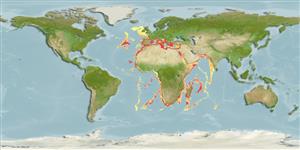Common names from other countries
Environment: milieu / climate zone / depth range / distribution range
Ekologi
; kisaran kedalaman 80 - 3300 m (Ref. 127635), usually 350 - 800 m (Ref. 80214). Tropical, preferred 19°C (Ref. 107945); 49°N - 30°S, 41°W - 75°E
Eastern Atlantic, Mediterranean and Western Indian Ocean: from Brazil to France, south to Natal, South Africa and east to Maldives.
Length at first maturity / Size / Weight / umur
Maturity: Lm 3.2 range ? - ? cm Max length : 22.0 cm TL jantan/; (Ref. 8); 7.1 cm CL (female); Umur maksimum dilaporkan: 6 Tahun (Ref. 80242)
Demersal (Ref. 80214). Maximum length for females from Ref. 80234. Demersal on muddy bottoms of slopes of continental shelf, in zones close to submarine canyons. Moves from depths of 200 m during the night to 800 m during the day, and changes location within the year (Ref. 80214). Feeds on small benthic invertebrates mainly crustaceans and polychaetes and also carrion (Ref. 434).
Members of the order Decapoda are mostly gonochoric. Mating behavior: Precopulatory courtship ritual is common (through olfactory and tactile cues); usually indirect sperm transfer.
rujukan utama
Acuan | Koordinator | mitra
Holthuis, L.B. 1980. (Ref. 8)
Status IUCN Red List (Ref. 130435)
status CITES (Ref. 108899)
Not Evaluated
Not Evaluated
penggunaan manusia
Perikanan: bernilai komersial tinggi
FAO - Perikanan: landings, profail spesis | FIRMS (Stock assessments) | FishSource | Sea Around Us
Alat, peralatan
Sumber internet
Estimates based on models
Preferred temperature
(Ref.
115969): 6.6 - 18.3, mean 13.3 (based on 351 cells).
Daya lenting
Tinggi, Waktu penggandaan populasi minimum kurang dari 15 bulan (K=0.14-0.99; tmax=6).
Prior r = 0.66, 95% CL = 0.44 - 0.99, Based on 7 full stock assessments.
keancaman
Low vulnerability (12 of 100).
